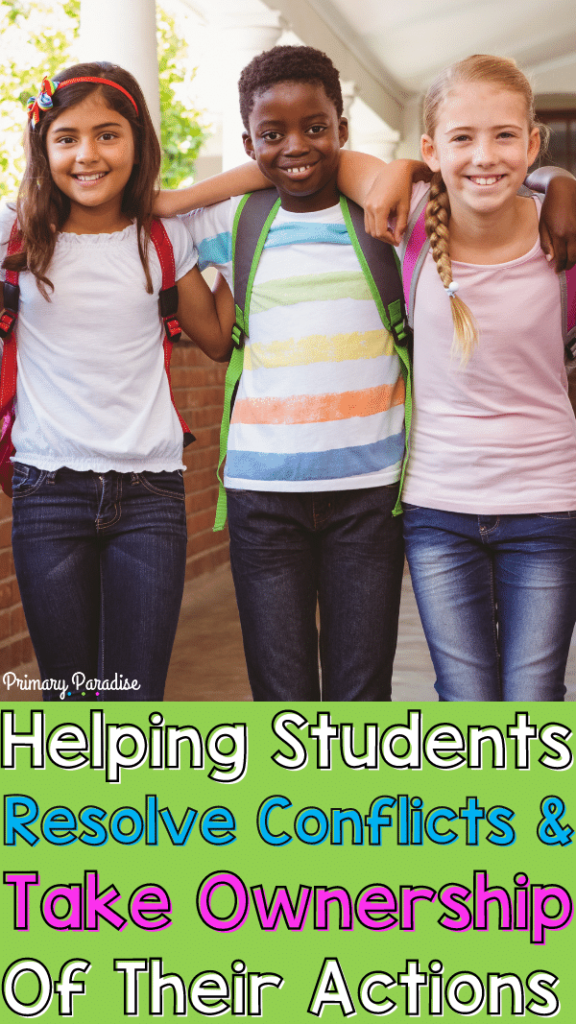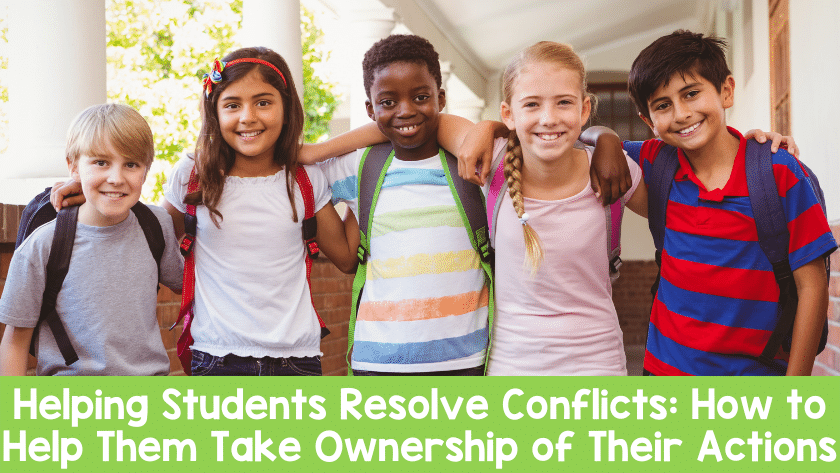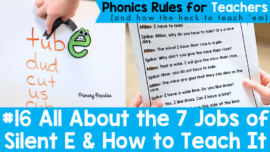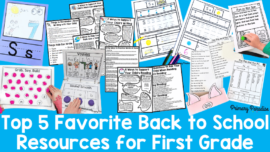Conflict resolution in elementary school is important because conflicts are common between students. As a teacher, one of our biggest goals should be to help students learn to solve conflict, take ownership of their actions, and then ultimately begin to solve conflicts on their own. Here is how to help students solve conflicts and take ownership of their own actions.
Don’t Force Students to Apologize
Although it might seem like the easiest solution, simply making students apologize and move on doesn’t typically work. Research shows that forced apologies just don’t have the desired result. When we make students apologize, they typically just say the words “I’m sorry” but will not ultimately change their actions. (Think about if/when you were made to apologize as a kid.) Apologies only work if they’re genuine.
Talk It Out
Although it takes a lot more time then just telling kids to say sorry, the first step in conflict resolution and helping students take ownership of their choices is to talk it out. Give everyone involved a chance to share their side uninterrupted.
It’s important to set the ground rules ahead of time. I typically say that our shared goal is to solve the problem, but first we need to know what the problem is. Then, we set ground rules. Everyone gets to talk and share their side. Everyone else listens, we don’t interrupt. We try to listen to learn how the other person feels.
It can depend on the situation, but typically I let the person who has been hurt of offended go first. They are able to present their side without being interrupted. The other party or parties need to listen. Then, each other person involved gets to have a turn.
This, at least at first, should be done with a teacher’s guidance to make sure things stay respectful. It’s possible with older students that the kids can talk it out on their own, but it really is best to have a teacher mediate.
Teachers Mediate
These conversations aren’t always easy, so it’s important that you, as the teacher, can support your students. You can give students sentence stems to better express themselves. “I felt — when you —.” It’s also helpful to remind students to start with “I”. So, instead of saying “You were so rude! You are so mean!” Students can say “I was very upset when you called me a name. It made me feels very angry and that’s why I pushed you.”
Put The Responsibility Back on the Students
When possible, put the ball back in the students’ court. Once they’ve shared their sides, ask a question like: “How can we solve this problem?” or “What could we have done differently?” or “What should we do next time to avoid this situation happening again?”
You’ll be surprised at how insightful and reflective students can be. They often have great solutions, and when they come up with the fix, that’s where they are able to take ownership of their actions.
Teach Students to Apologize
Typically, students will come to the conclusion that they need to apologize. It’s important to help them understand how to apologize so it actually feels genuine. I teach my students to say “I’m sorry for __. Is there anything I can do to make it better?” Often times, the other child will say it’s okay, but sometimes they actually will say things like “next time can you please not yell?” “Next time can we all play together?” “I just want some space to calm down. “
Again, this places the responsibility back onto the students to resolve the conflict. I can’t tell you how often I now will hear that kind of genuine apology without any guidance and input from me.
Make Agreements If Necessary
For some issues, particularly ongoing issues, it might need more than just an apology. Sometimes you might need to help the students come up with some essential agreements. Unfortunately, sometimes certain students just don’t seem to get along well, but essential agreements can help them still be civil and respectful. Essential agreements are just a list of things that both parties agree to.
For example, if two groups of students don’t like how the other group is playing. Maybe a group of kids keep chasing the other group, and then the other group is trying to get them to stop by pushing them. They might sit down and come up with essential agreements like this “We won’t chase each other.” “We won’t push each other.” “We will only play together if everyone agrees on the rules.” “If we have a problem we will ask Ms. Martha to help us discuss it.” Once students write their agreements, all parties involved sign them.
Things to Keep in Mind with Conflict Resolution in the Classroom
Practice BEFORE There is Conflict
If possible, practice conflict resolution BEFORE there’s actually conflict so students already have some ideas as to how to solve conflicts in a respectful way. You can do this through read alouds, role play, and scenarios. Giving students the chance to discuss respectful ways to handle made up conflicts will help them have the skills when the real thing comes up.
Model
Conflicts aren’t always only between students. At times, you might find yourself in conflict with a student. I find one of the best ways to teach conflict resolution skills is to model them when there’s an issue with a student. This works well even with something as simple as a student who is constantly talking over you in class, for example. You can take them aside and talk it out.
With students, I typically let them share their side first so they know I do value their opinion. Then, I would say something like “I feel very frustrated when you’re talking over me because you will miss the directions and then ask later. This takes time I could be helping students and means I have to reexplain the directions. Or, it means you have to try to guess what you’re supposed to do.”
In the end, you might realize that the student needs a notebook to write down their thoughts, or they simply just need a non-verbal reminder when they’re talking out of turn. Of course, this doesn’t make sense for every situation, but it does show students that everyone has conflict and we can all choose to handle it in a respectful manner.
Give It Time
Just like adding or subtracting, learning to resolve conflict is a skill. It will take time for students to handle conflict resolution well. But, if you remain consistent in your approach, students will get better and better at resolving conflicts.
Keep reading and learning:
What I Do With Old Anchor Charts
Supporting Left Handed Students
Using Partner Plays to Develop Fluency




